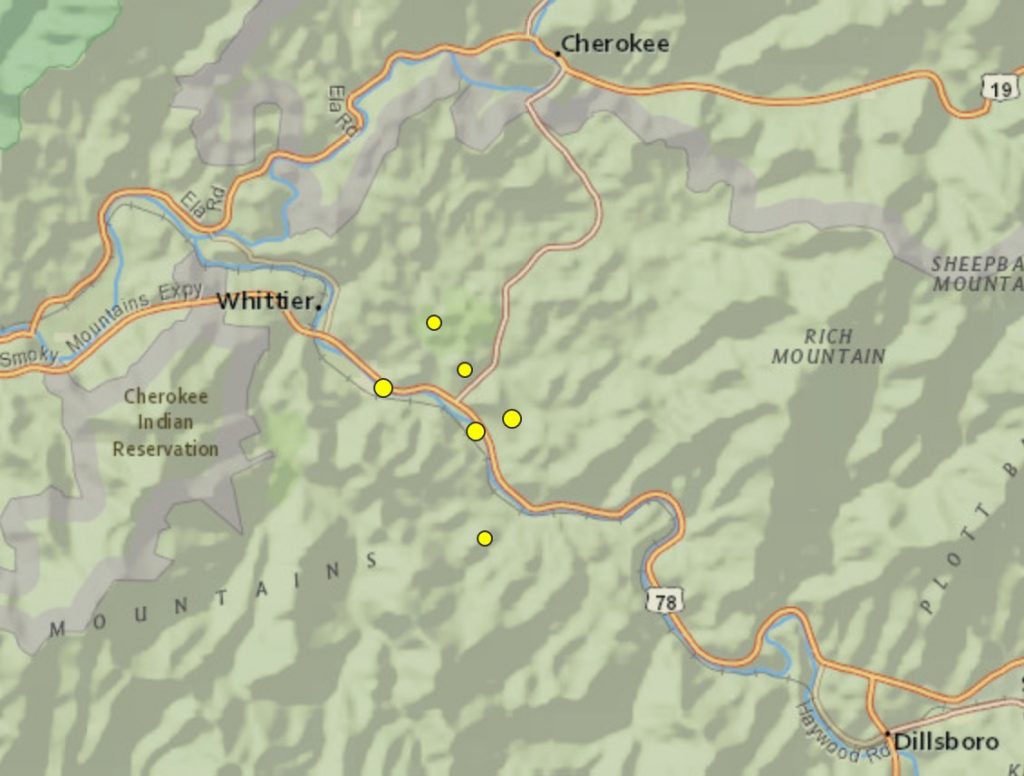There are no active fault zones in North Carolina.
But one area of the North Carolina mountains has had eight small earthquakes within a week. Weird, no?

The quakes have all been within a couple miles of each other near Cherokee, North Carolina, in the Great Smoky Mountains.
None of the earthquakes caused damage or injuries.
The biggest quake measured M2.5 and occurred around 11:30 p.m. Wednesday about 2.5 miles southwest of Cherokee. Below a summary of the tremors:
- Sept. 7, 8:14 p.m.: 1.9 magnitude, 5 miles south of Cherokee
- Sept. 9, 4:21 a.m.: 1.4 magnitude, 3.1 miles south-southwest of Cherokee
- Sept. 9, 3:08 p.m.: 2.0 magnitude, 3.1 miles south-southwest of Cherokee
- Sept. 11, 8:13 p.m.: 2.3 magnitude, 3.7 miles south of Cherokee
- Sept. 11, 11:03 p.m.: 2.5 magnitude, 2.5 miles southwest of Cherokee
- Sept. 11, 11:14 p.m.: 2.1 magnitude, 3.7 miles south-southwest of Cherokee
- Sept. 13, 5:25 p.m: 2.4 magnitude, 3.7 miles east of Advance
- Sept. 13, 10:48 p.m: 2.0 magnitude, 1.5 near Greensboro
The earthquakes were all low intensity. More than 44 people reported feeling the strongest quake on the USGS webpage, while only a handful of people reported feeling the other earthquakes.
According to WFMY News people felt their house shake and heard a loud “boom” that sounded like an explosion in the 2.3-magnitude earthquake that hit in between Arcadia and Advance. Others felt the quake as far away as Winston-Salem.
Fault Lines and Earthquakes in North Carolina
The major faults of Western North Carolina discovered thus far are ancient, and none are known to be active. With further detailed geologic mapping, more fault lines will likely be identified.
The most significant fault in the region is the Brevard fault zone, which extends from Alabama to Virginia across North Carolina, where it coincides with a long, linear topographic low. Another major fault in the region is the Linville Falls fault.
The known faults do not correspond with the locations of historic earthquake epicenters which are:
- Wilkes County M5.1 Earthquake – August 31, 1861.
- Skyland M5.5 Earthquake – February 21, 1916.
- Mitchell County M5.2 Earthquake – July 8, 1926.
So sometimes, North Carolina experiences earthquakes. Large and damaging earthquakes are rare, with most earthquakes having a magnitude of less than 3.0. But such a high number of eartquakes in such a short timescale is kind of weird for this state situated upon a passive and not active continental margin.












